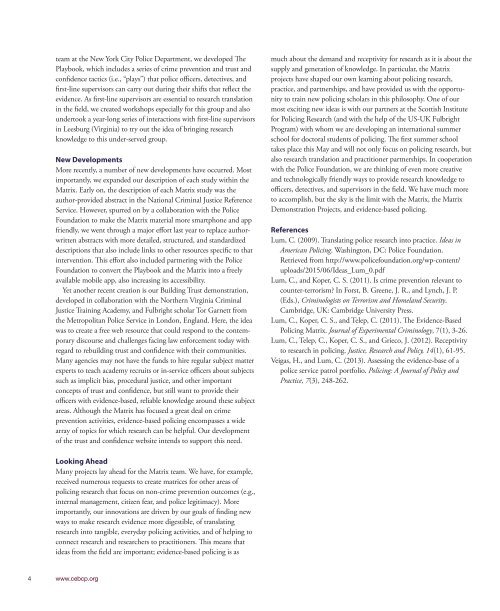Translational Criminology
TC10-Spring2016
TC10-Spring2016
You also want an ePaper? Increase the reach of your titles
YUMPU automatically turns print PDFs into web optimized ePapers that Google loves.
team at the New York City Police Department, we developed The<br />
Playbook, which includes a series of crime prevention and trust and<br />
confidence tactics (i.e., “plays”) that police officers, detectives, and<br />
first-line supervisors can carry out during their shifts that reflect the<br />
evidence. As first-line supervisors are essential to research translation<br />
in the field, we created workshops especially for this group and also<br />
undertook a year-long series of interactions with first-line supervisors<br />
in Leesburg (Virginia) to try out the idea of bringing research<br />
knowledge to this under-served group.<br />
New Developments<br />
More recently, a number of new developments have occurred. Most<br />
importantly, we expanded our description of each study within the<br />
Matrix. Early on, the description of each Matrix study was the<br />
author-provided abstract in the National Criminal Justice Reference<br />
Service. However, spurred on by a collaboration with the Police<br />
Foundation to make the Matrix material more smartphone and app<br />
friendly, we went through a major effort last year to replace authorwritten<br />
abstracts with more detailed, structured, and standardized<br />
descriptions that also include links to other resources specific to that<br />
intervention. This effort also included partnering with the Police<br />
Foundation to convert the Playbook and the Matrix into a freely<br />
available mobile app, also increasing its accessibility.<br />
Yet another recent creation is our Building Trust demonstration,<br />
developed in collaboration with the Northern Virginia Criminal<br />
Justice Training Academy, and Fulbright scholar Tor Garnett from<br />
the Metropolitan Police Service in London, England. Here, the idea<br />
was to create a free web resource that could respond to the contemporary<br />
discourse and challenges facing law enforcement today with<br />
regard to rebuilding trust and confidence with their communities.<br />
Many agencies may not have the funds to hire regular subject matter<br />
experts to teach academy recruits or in-service officers about subjects<br />
such as implicit bias, procedural justice, and other important<br />
concepts of trust and confidence, but still want to provide their<br />
officers with evidence-based, reliable knowledge around these subject<br />
areas. Although the Matrix has focused a great deal on crime<br />
prevention activities, evidence-based policing encompasses a wide<br />
array of topics for which research can be helpful. Our development<br />
of the trust and confidence website intends to support this need.<br />
much about the demand and receptivity for research as it is about the<br />
supply and generation of knowledge. In particular, the Matrix<br />
projects have shaped our own learning about policing research,<br />
practice, and partnerships, and have provided us with the opportunity<br />
to train new policing scholars in this philosophy. One of our<br />
most exciting new ideas is with our partners at the Scottish Institute<br />
for Policing Research (and with the help of the US-UK Fulbright<br />
Program) with whom we are developing an international summer<br />
school for doctoral students of policing. The first summer school<br />
takes place this May and will not only focus on policing research, but<br />
also research translation and practitioner partnerships. In cooperation<br />
with the Police Foundation, we are thinking of even more creative<br />
and technologically friendly ways to provide research knowledge to<br />
officers, detectives, and supervisors in the field. We have much more<br />
to accomplish, but the sky is the limit with the Matrix, the Matrix<br />
Demonstration Projects, and evidence-based policing.<br />
References<br />
Lum, C. (2009). Translating police research into practice. Ideas in<br />
American Policing. Washington, DC: Police Foundation.<br />
Retrieved from http://www.policefoundation.org/wp-content/<br />
uploads/2015/06/Ideas_Lum_0.pdf<br />
Lum, C., and Koper, C. S. (2011). Is crime prevention relevant to<br />
counter-terrorism? In Forst, B. Greene, J. R., and Lynch, J. P.<br />
(Eds.), Criminologists on Terrorism and Homeland Security.<br />
Cambridge, UK: Cambridge University Press.<br />
Lum, C., Koper, C. S., and Telep, C. (2011). The Evidence-Based<br />
Policing Matrix. Journal of Experimental <strong>Criminology</strong>, 7(1), 3-26.<br />
Lum, C., Telep, C., Koper, C. S., and Grieco, J. (2012). Receptivity<br />
to research in policing. Justice, Research and Policy, 14(1), 61-95.<br />
Veigas, H., and Lum, C. (2013). Assessing the evidence-base of a<br />
police service patrol portfolio. Policing: A Journal of Policy and<br />
Practice, 7(3), 248-262.<br />
Looking Ahead<br />
Many projects lay ahead for the Matrix team. We have, for example,<br />
received numerous requests to create matrices for other areas of<br />
policing research that focus on non-crime prevention outcomes (e.g.,<br />
internal management, citizen fear, and police legitimacy). More<br />
importantly, our innovations are driven by our goals of finding new<br />
ways to make research evidence more digestible, of translating<br />
research into tangible, everyday policing activities, and of helping to<br />
connect research and researchers to practitioners. This means that<br />
ideas from the field are important; evidence-based policing is as<br />
4 www.cebcp.org


